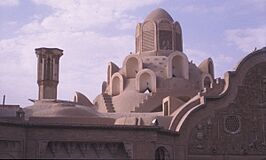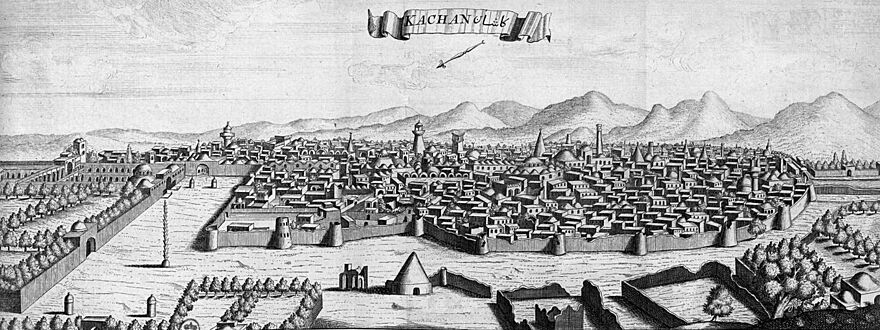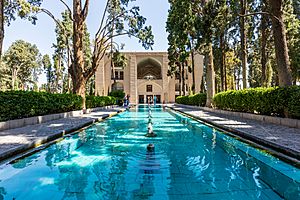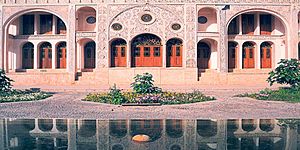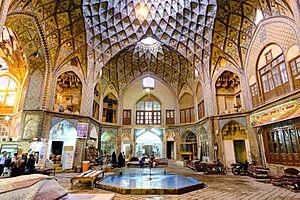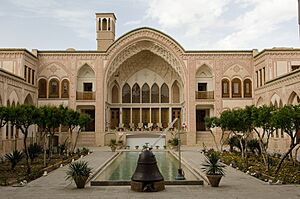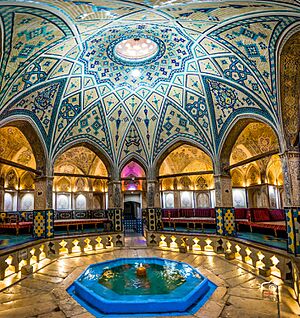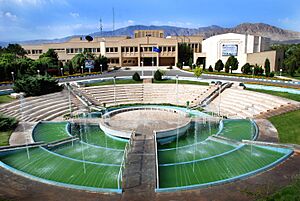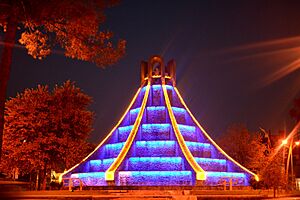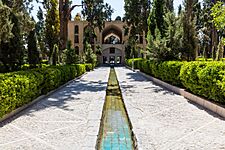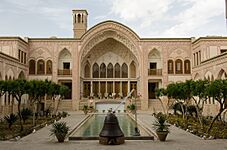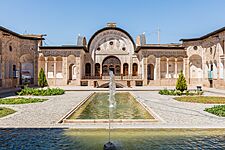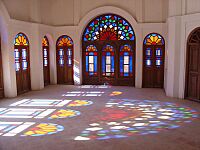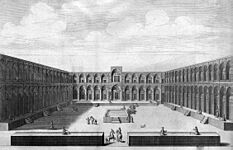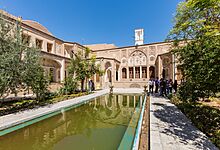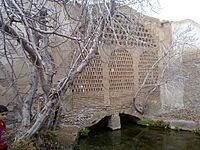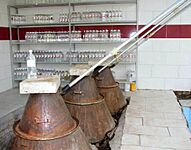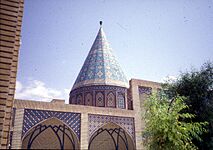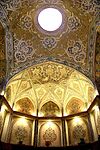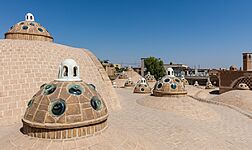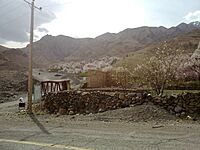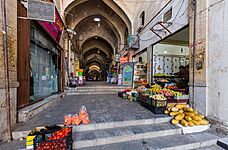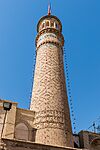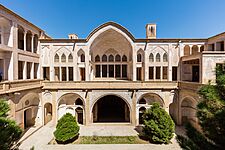Kashan facts for kids
Quick facts for kids
Kashan
کاشان
|
|
|---|---|
|
City
|
|
|
Clockwise from the top:
Borujerdi House, Sultan Amir Ahmad Bathhouse, Tabatabai House, Agha Bozorg Mosque, Fin Garden. |
|
| Country | Iran |
| Province | Isfahan |
| County | Kashan |
| District | Central |
| Population
(2016)
|
|
| • Urban | 304,487 |
| • Metro | 432,557 |
| Time zone | UTC+3:30 (IRST) |
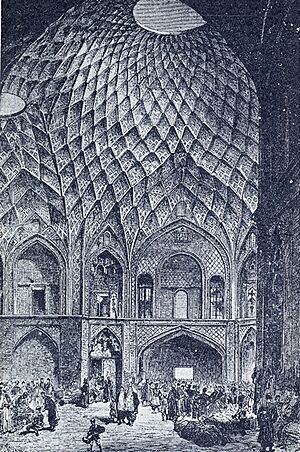
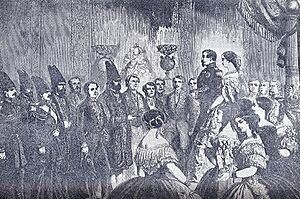
Kashan (Persian: کاشان) is an old city in Iran. It is located in the northern part of Isfahan province. Kashan is the capital of both Kashan County and its Central District.
Contents
History of Kashan
The earliest signs of people living near Kashan go back to the Paleolithic period. Stone tools from this time have been found in areas like Niasar.
Some stories say that Kashan was the home of the three wise men. These men followed a star to Bethlehem to see the birth of Jesus. A traveler named Friar Odoric of Pordenone shared this story in 1330.
There is a legend from the Safavid era about a craftsman named Abu Lu'lu'a. He was a Persian who was enslaved by Islamic conquerors. He later assassinated the caliph Umar ibn al-Khattab in 644. The legend says he fled to Kashan after this event. A shrine built over his supposed tomb is a famous landmark in Kashan.
During the Timurid Empire rule, Kashan was supported by Ulugh Beg. Later, it was ruled by the Qara Qoyunlu and then the Aq Qoyunlu. Kashan was also a favorite vacation spot for Safavid kings.
In 1778, a big earthquake hit Kashan. It destroyed the city and many buildings, causing 8,000 deaths. But the city was rebuilt and started fresh.
Population of Kashan
In 2006, Kashan had about 248,789 people. By 2016, the population grew to 304,487 people.
Geography of Kashan
Kashan is split into two main areas: mountains and desert.
Location of Kashan
Kashan is in the north of Isfahan province. It is north of the Karkas Mountains and west of the Dasht-e Kavir desert. This desert area has little plant life, mostly bushes and shrubs.
Mountains Near Kashan
Dare mountain is 14 kilometers southwest of Kashan. It is 2,985 meters high and overlooks the city. Gargash peak is the second highest peak in the Karkas mountain range. It is 3,600 meters high.
Kashan has very little light and air pollution. Because of this, experts chose it as the best place for the National Observatory of Iran. It is home to one of the largest telescopes in the Middle East.
Ardahal peak is 35 kilometers west of Kashan. It is 3,505 meters high. It is the highest point in the Kashan heights after Gargash.
Climate in Kashan
Kashan has a hot desert climate. This means it has cold winters, but they are warmer than in other Iranian cities. Summers are very hot and dry. Kashan is warmer than many other cities in the Iranian Plateau because it is at a lower elevation.
| Climate data for Kashan (1991–2020, records 1966-2020) | |||||||||||||
|---|---|---|---|---|---|---|---|---|---|---|---|---|---|
| Month | Jan | Feb | Mar | Apr | May | Jun | Jul | Aug | Sep | Oct | Nov | Dec | Year |
| Record high °C (°F) | 22.0 (71.6) |
27.0 (80.6) |
36.4 (97.5) |
37.0 (98.6) |
42.0 (107.6) |
48.0 (118.4) |
48.0 (118.4) |
47.1 (116.8) |
43.0 (109.4) |
39.0 (102.2) |
32.2 (90.0) |
24.5 (76.1) |
48.0 (118.4) |
| Mean daily maximum °C (°F) | 10.7 (51.3) |
14.2 (57.6) |
19.9 (67.8) |
26.0 (78.8) |
32.1 (89.8) |
38.1 (100.6) |
40.8 (105.4) |
39.7 (103.5) |
35.1 (95.2) |
27.5 (81.5) |
18.0 (64.4) |
12.2 (54.0) |
26.2 (79.2) |
| Daily mean °C (°F) | 4.9 (40.8) |
8.0 (46.4) |
13.4 (56.1) |
19.3 (66.7) |
25.1 (77.2) |
31.0 (87.8) |
33.7 (92.7) |
32.2 (90.0) |
27.3 (81.1) |
20.1 (68.2) |
11.8 (53.2) |
6.4 (43.5) |
19.4 (67.0) |
| Mean daily minimum °C (°F) | −0.2 (31.6) |
2.1 (35.8) |
6.9 (44.4) |
12.3 (54.1) |
17.4 (63.3) |
22.4 (72.3) |
25.4 (77.7) |
23.6 (74.5) |
18.9 (66.0) |
13.0 (55.4) |
6.1 (43.0) |
1.4 (34.5) |
12.4 (54.4) |
| Record low °C (°F) | −17.4 (0.7) |
−10.0 (14.0) |
−4.5 (23.9) |
0.0 (32.0) |
5.4 (41.7) |
10.6 (51.1) |
15.2 (59.4) |
12.4 (54.3) |
10.0 (50.0) |
4.5 (40.1) |
−8.6 (16.5) |
−8.0 (17.6) |
−17.4 (0.7) |
| Average precipitation mm (inches) | 20.6 (0.81) |
15.1 (0.59) |
26.3 (1.04) |
21.6 (0.85) |
14.0 (0.55) |
1.5 (0.06) |
0.4 (0.02) |
0.5 (0.02) |
0.3 (0.01) |
4.7 (0.19) |
14.6 (0.57) |
14.7 (0.58) |
134.3 (5.29) |
| Average snowfall cm (inches) | 12.2 (4.8) |
3.5 (1.4) |
1.0 (0.4) |
0.0 (0.0) |
0.0 (0.0) |
0.0 (0.0) |
0.0 (0.0) |
0.0 (0.0) |
0.0 (0.0) |
0.0 (0.0) |
0.1 (0.0) |
1.4 (0.6) |
18.2 (7.2) |
| Average precipitation days (≥ 1.0 mm) | 4.1 | 2.8 | 3.8 | 3.5 | 2.1 | 0.5 | 0.2 | 0.1 | 0.2 | 1.2 | 2.7 | 3.1 | 24.3 |
| Average snowy days | 2.7 | 1.2 | 0.5 | 0.0 | 0.0 | 0.0 | 0.0 | 0.0 | 0.0 | 0.0 | 0.1 | 1.0 | 5.5 |
| Average relative humidity (%) | 61 | 52 | 43 | 40 | 33 | 22 | 21 | 22 | 25 | 37 | 53 | 62 | 39 |
| Average dew point °C (°F) | −2.8 (27.0) |
−2.5 (27.5) |
−0.6 (30.9) |
3.4 (38.1) |
5.8 (42.4) |
5.6 (42.1) |
7.0 (44.6) |
6.3 (43.3) |
4.6 (40.3) |
3.6 (38.5) |
1.2 (34.2) |
−1.0 (30.2) |
2.6 (36.6) |
| Mean monthly sunshine hours | 187 | 194 | 222 | 234 | 282 | 329 | 332 | 341 | 306 | 264 | 192 | 176 | 3,059 |
| Source 1: NCEI(snowfall 1981-2010) | |||||||||||||
| Source 2: IRIMO(snow days and extremes 1966-2010)[1] | |||||||||||||
Main Sights in Kashan
On August 9, 2007, Iran suggested that the historical areas of Fin, Sialk, and Kashan could become a UNESCO World Heritage Site. In 2012, the Fin Garden was successfully added to UNESCO's Persian Gardens World Heritage Site list.
Some of Kashan's famous buildings and places include:
- Abbāsi House
- Agha Bozorg Mosque
- Āmeri House
- Bazaar of Kashan
- Boroujerdi House
- Fin Garden
- Jalali Castle
- Jameh Mosque of Kashan
- Meydan Mosque
- Shrine of Abu Lu'lu'a
- Sultan Amir Ahmad Bathhouse
- Tabātabāei House
- Tabriziha Mosque
- Tepe Sialk
Kashan Today
Kashan is well-known for making carpets, silk, and other textiles.
Education in Kashan
More than 10,000 students study in Kashan. They learn about many subjects. These include science, engineering, art, law, and medical sciences. They also study nanotechnology, literature, carpets, and handicrafts.
Colleges and universities in Kashan are:
- Kashan University of Medical Sciences
- Islamic Azad University of Kashan
- University of Kashan
Getting to Kashan
You can reach Kashan by:
- Road 71
- Freeway 7, which is close to the city.
Kashan is connected by freeways to Isfahan and Natanz to the south. It is also connected to Qom to the north, which is about an hour's drive away. The Kashan railway station is on Iran's main north-south railway lines. Kashan Airport reopened in 2016.
Famous People from Kashan
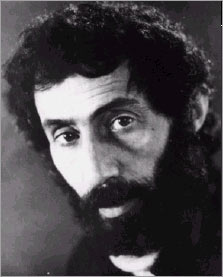
- David Alliance, Baron Alliance
- Ghyath ad-Din Jamshid Kashani
- Kamal-ol-Molk
- Amir Ghafour
- Ehsan Hajsafi
- Javad Kazemian
- Mohsen Feyz Kashani
- Sohrab Sepehri
- Ustad Ali Maryam
- Afdal al-Din Kashani
- Reza Abbasi
- Sani ol molk
- Kalim Kashani
- Muhtasham Kashani
- Ghotb Ravandi
- Saeed Hajjarian
- Mohammad Motamedi
- Mulla Muhammad Mahdi Naraqi
- Molla Fathollah Kashani
- Sani ol molk
- Moluk Zarabi
- Pari Zangeneh
Sister Cities
Kashan has one sister city:
 Neishabour, Iran
Neishabour, Iran
Gallery
See also
 In Spanish: Kashan para niños
In Spanish: Kashan para niños


